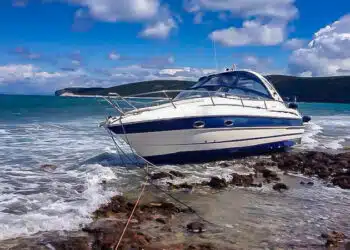The question of whether the respective quarantine ordinances of the individual federal states are still valid could only be conclusively and resiliently clarified today due to the holiday on Thursday. In addition the Federal Ministry of Health explained on inquiry: The entry regulation stepped on 13.5. into force. It applies nationwide and -uniformly. We have compiled information here. Individual states, however, as was further communicated, can issue regulations that go beyond this. Important for travelers from North Rhine-Westphalia who enter Germany from high incidence areas: For you now also applies the 10-day quarantine, which can be canceled only after the fifth day by a test.
.
Good news for boat owners, yacht owners and holidaymakers in general: Germany has, in time for Whitsuntide, changed the entry regulations for return travelers from Italy and Austria, which are currently classified as risk areas according to the Robert Koch Institute are currently classified as risk areas, have been amended to no longer require quarantine of vaccinated, recovered and tested individuals, derive from the Revision of the Coronavirus Entry Ordinance of May 12, 2021 results. No changes currently occurred for return travel from Croatia and Slovenia, as these two countries are classified as high-incidence areas because of the still-high 7-day incidence.
Here is still valid: Ten days quarantine, which can be broken off at the earliest after the fifth day by a negative test.
Look into the Corona entry regulation Germany
For all those who do not want to deal with the difficult matter of the legal texts, here is a brief summary of what applies in each case when entering Germany from May 12, 2021.
Quarantine on entry from Italy or Austria to Germany is not applicable
According to Section 4, Paragraph 1 of the German Coronavirus Entry Ordinance, a general quarantine obligation already applies to entrants from risk areas. Paragraph 2 then describes the exception for convalescents, vaccinated and tested persons entering Germany from Italy.
There it says literally:
The segregation according to paragraph 1 sentence 1 shall be for a period of ten days. Notwithstanding the first sentence, the segregation ends before the expiry of ten days for recovered, vaccinated or tested persons if they submit the proof of recovery, proof of vaccination or proof of testing in accordance with § 7 paragraph 4 sentence 1 to the competent authority.
In plain language, this means: Who, for example, still in the vacation country, so Italy or Austria has been tested, does not have to quarantine when entering Germany. This provision also applies to children who have reached the age of six.
Quarantine when entering Germany from Slovenia and Croatia
Since both Slovenia and Croatia are still classified as coronavirus high incidence areas by the German Federal Ministry of Health as well as the Robert Koch Institute, other quarantine rules apply here, as described in Section 4 (1) of the regulation.
There it is said:
For persons who at any time in the last ten days before entry have stayed in an area classified as a high incidence area at the time of entry, the underlying testing may not have taken place earlier than five days after entry.
Also here in plain language: Who enters from a vacation in Slovenia or Croatia to Germany, for the first time nothing changes, after entering Germany ten days of quarantine apply, which can be broken off at the earliest after five days by a negative test.
Classification for entry into Germany: risk area or high-incidence area?
Regarding the classification as a risk area, which is relevant for entry from Slovenia, Italy and Croatia to Germany, the criteria are listed again here: If the 7-day incidence is between 50 and 200, a country is considered a coronavirus risk area. This now includes 18 of the 26 EU member states, but just unfortunately not yet in the long term Croatia with a current (as of May 12, 2021) 7-day incidence of 187.9 or Slovenia with a 7-day incidence of 174.7, because on the cutoff date of the decision the incidence figures were above 200.
However, taking into account the current sharp decline in new infections in Croatia and Slovenia, Croatia and Slovenia should also be downgraded from high-incidence area to risk area status as early as the next update. Then the same conditions will apply for travelers returning to Germany as for those returning from Italy, i.e. after a test, for example in Croatia, quarantine will no longer apply. This should mean that nothing stands in the way of trips to Croatia.
High-incidence areas: more than 200 new infections per 100,000 inhabitants in 7 days
Countries with more than 200 new infections per 100,000 inhabitants in the last seven days are considered high-incidence areas, which are decisive for the quarantine obligation when entering Germany.
Quarantine for Croatia / Slovenia should be dropped before Pentecost
When will the quarantine regulations change when entering Germany from Croatia and Slovenia? No later than the next review of new infections by the Robert Koch Institute in conjunction with the Federal Ministry of Health, a downgrading of Croatia as a risk area is expected if the new infections continue to decline and the other parameters such as testing rate and protective measures are continued accordingly.
Boat owners, yacht owners and charter customers can start making travel preparations
What does this mean for German boat owners, yacht owners and charter customers? Anyone planning to use their boat or yacht over Whitsun, or planning a charter vacation, should already start carefully packing their bags. Although here or there the subjunctive is still involved, on the SeaHelp homepage and also in the SeaHelp app you can find the hard facts, updated daily, on the basis of which you can see whether the quarantine will not apply when entering Germany from Croatia or Slovenia. Currently, the omens clearly indicate that at Whitsun the wave of travel from Germany to Croatia and Slovenia can roll. To Italy anyway.













